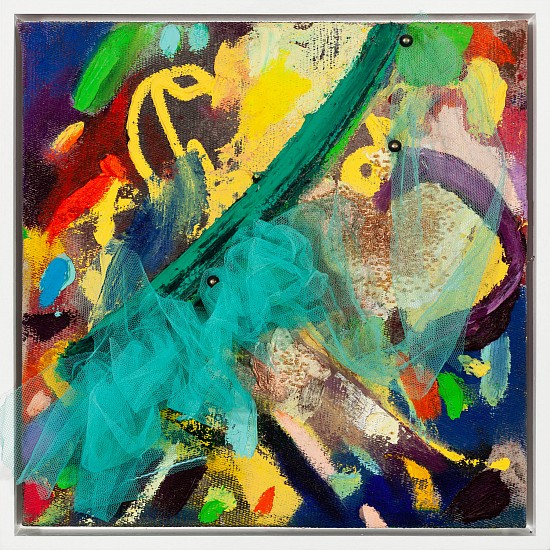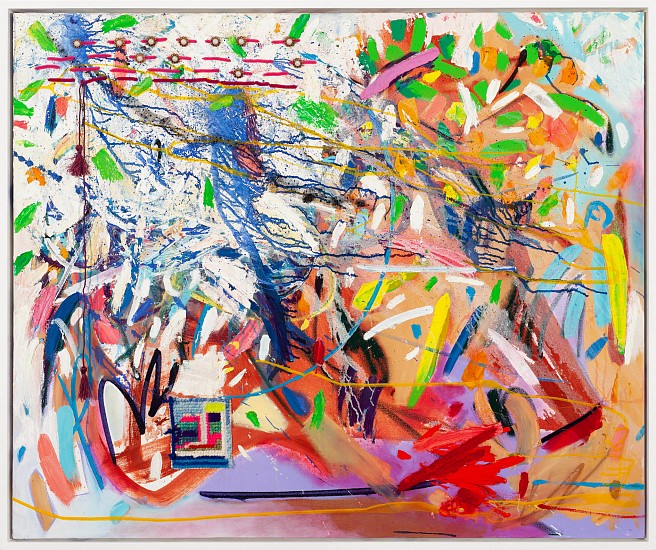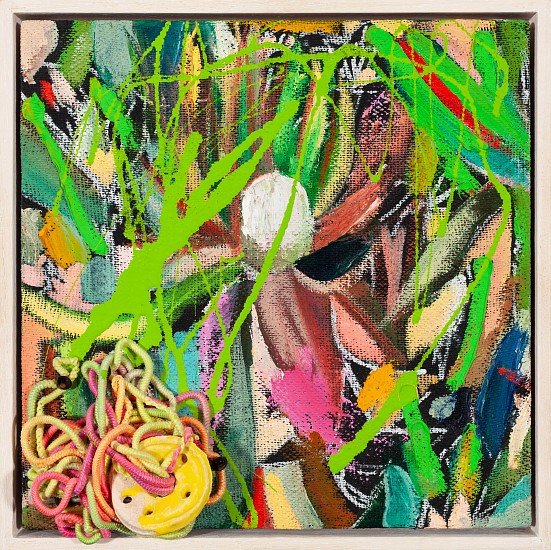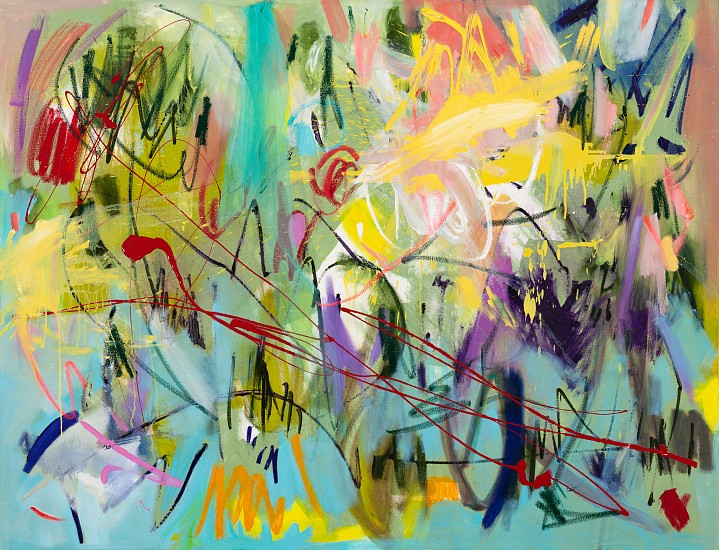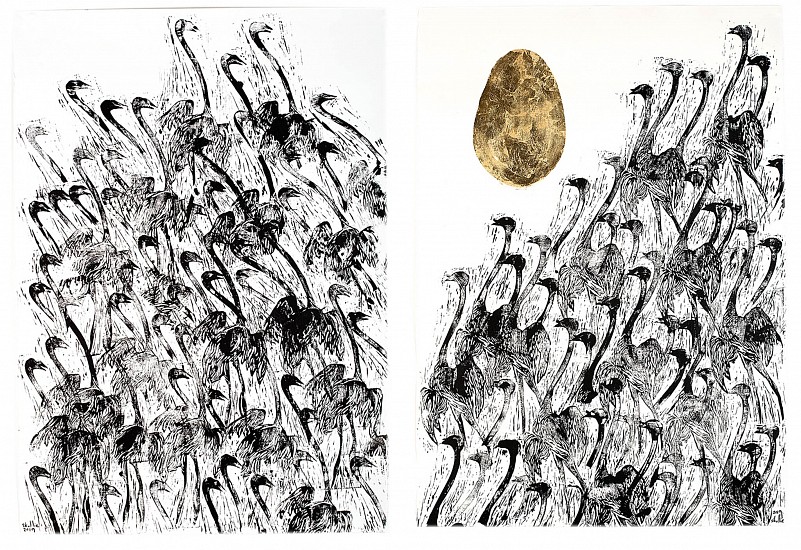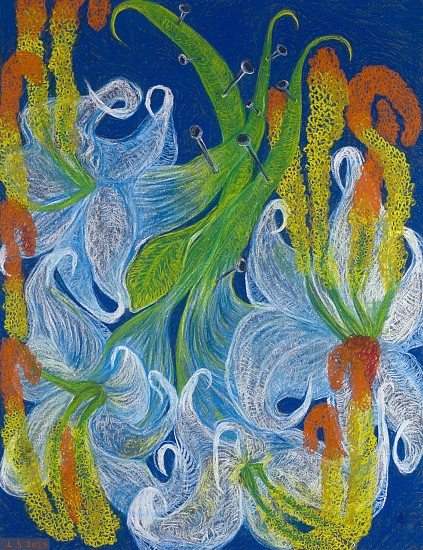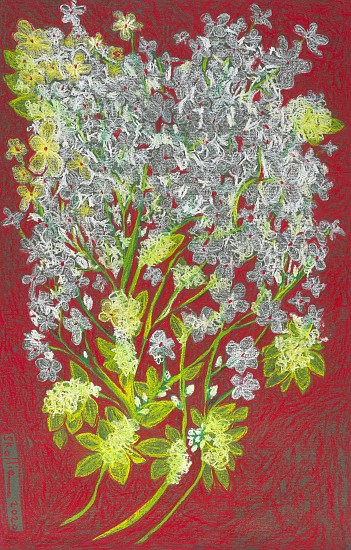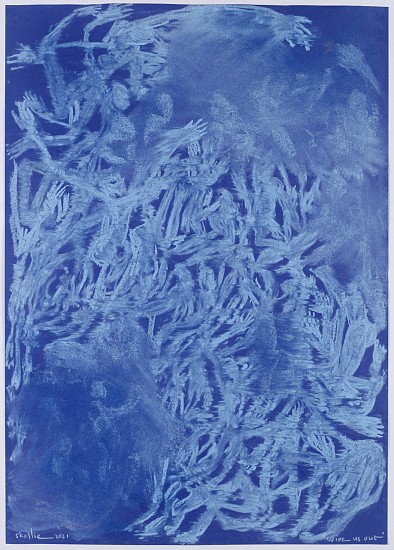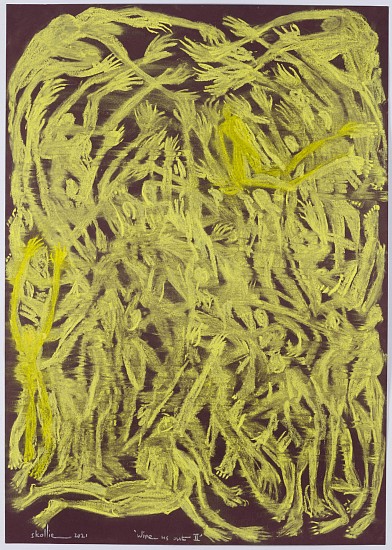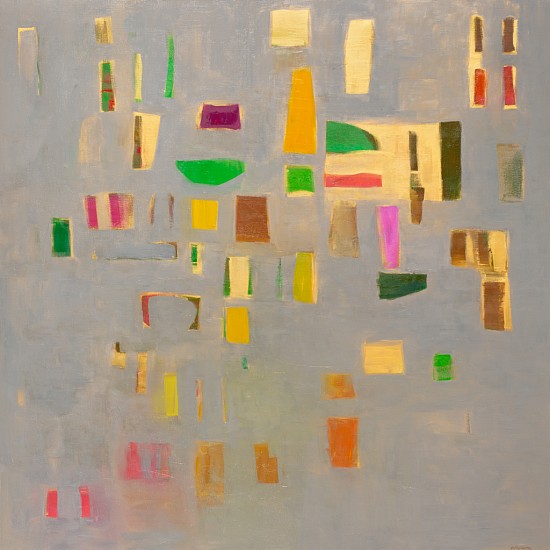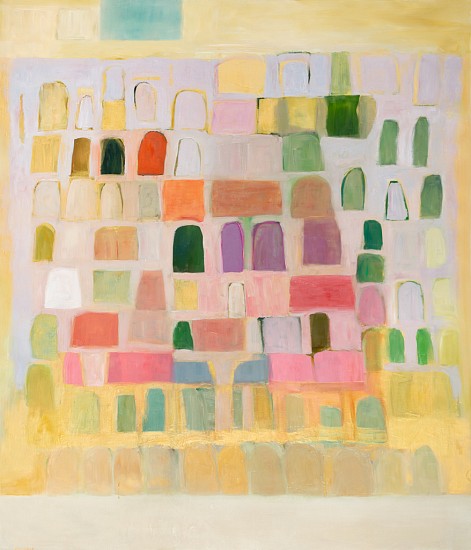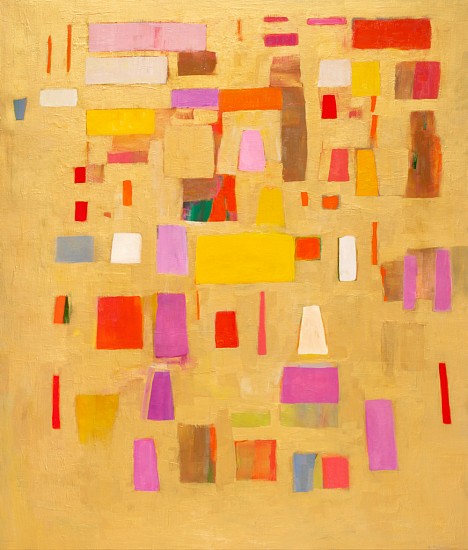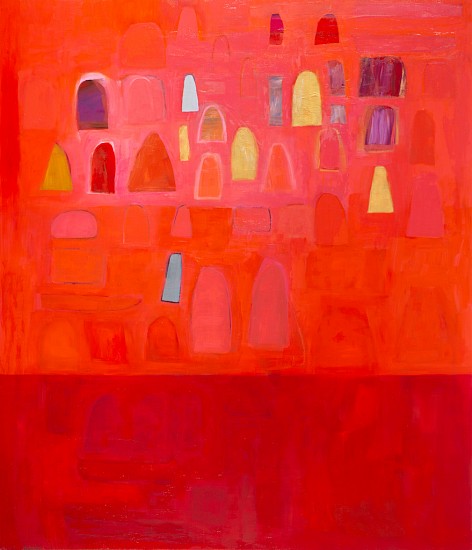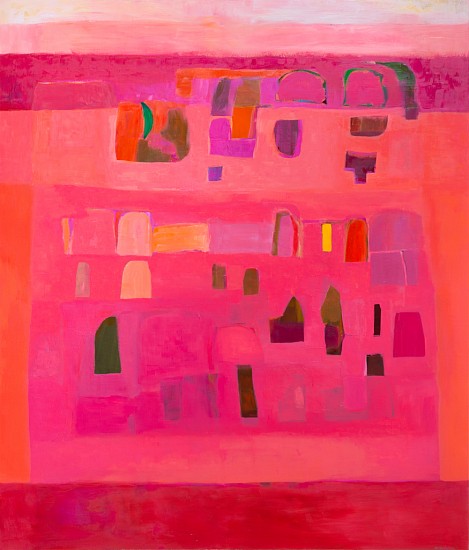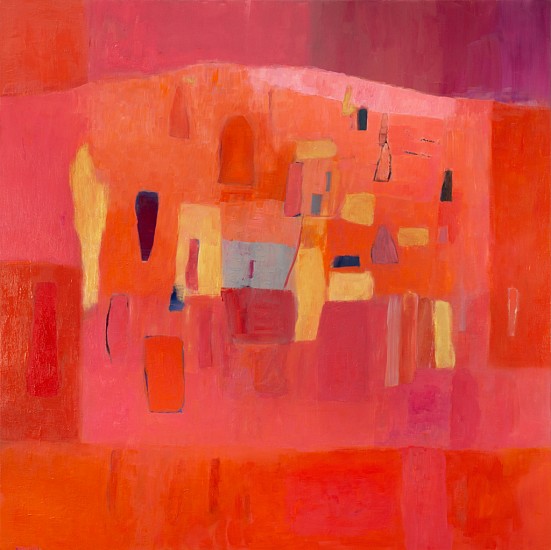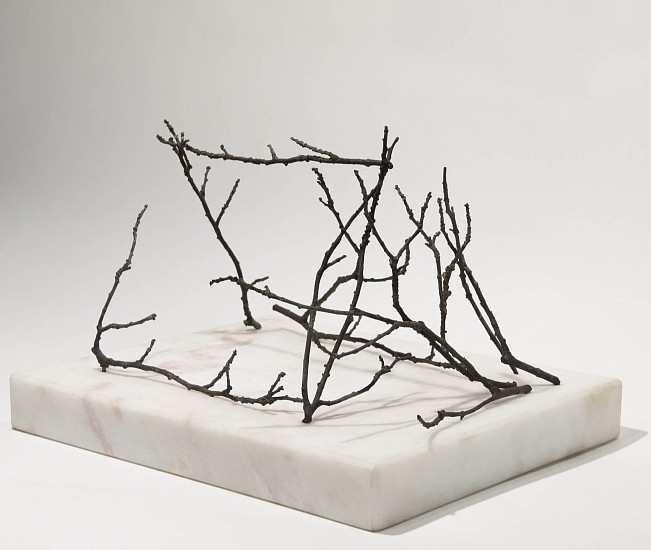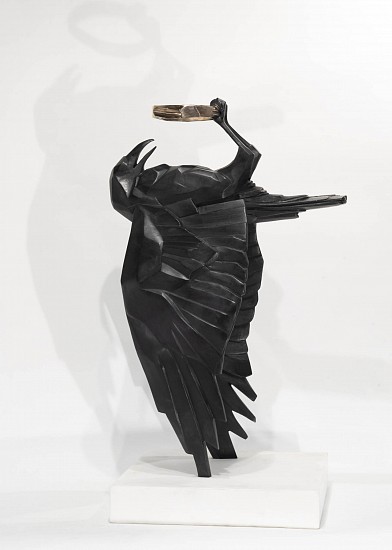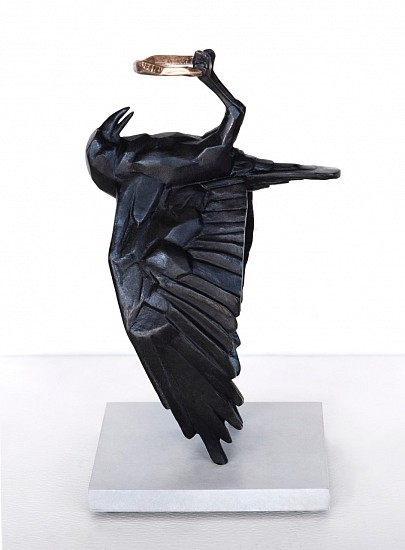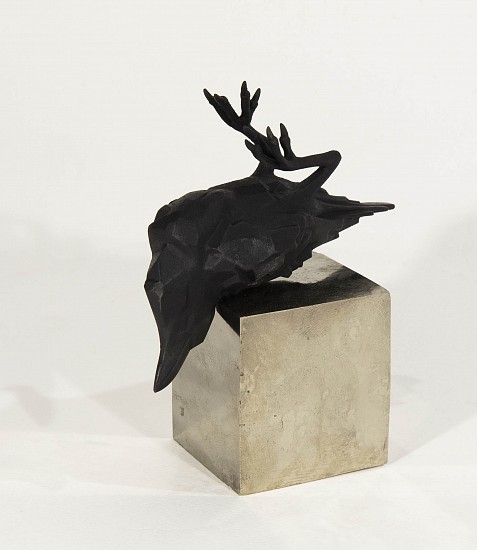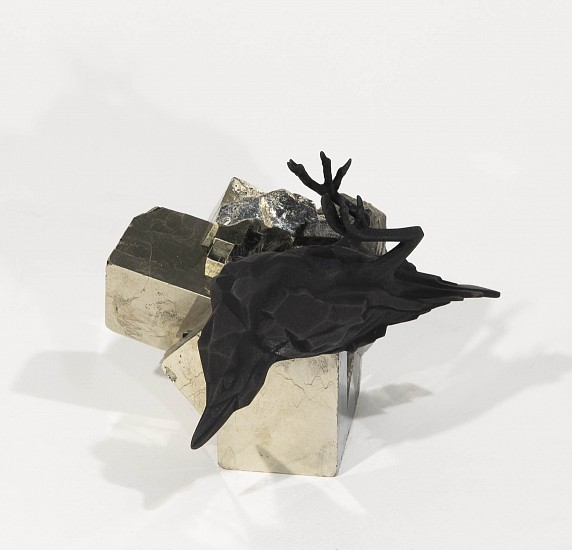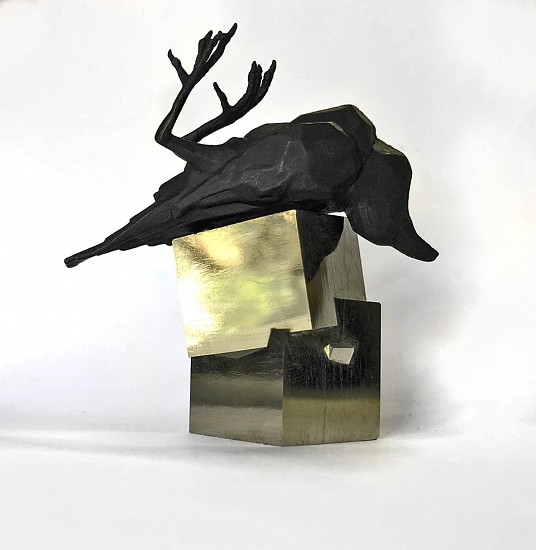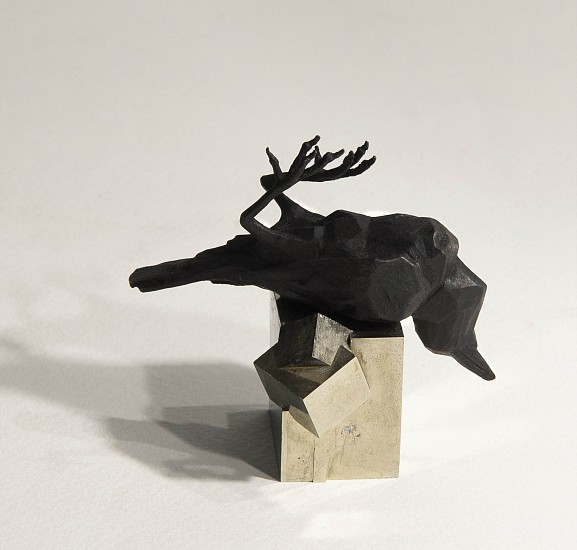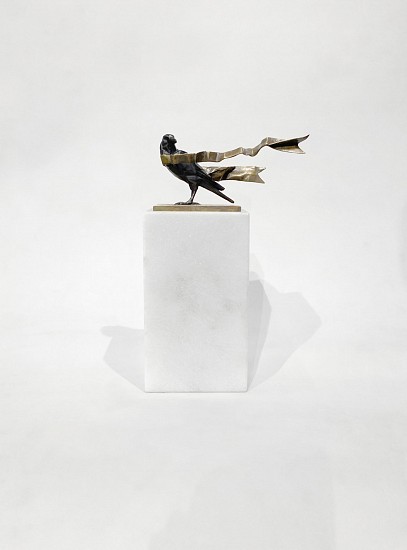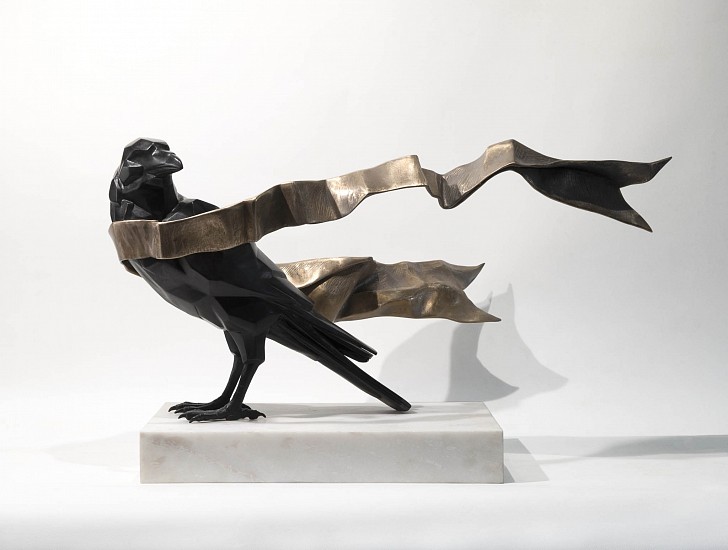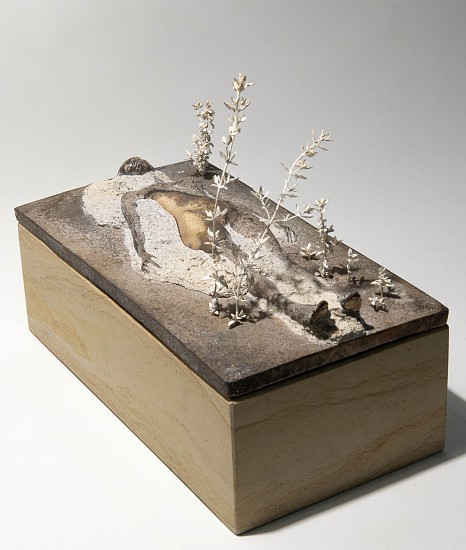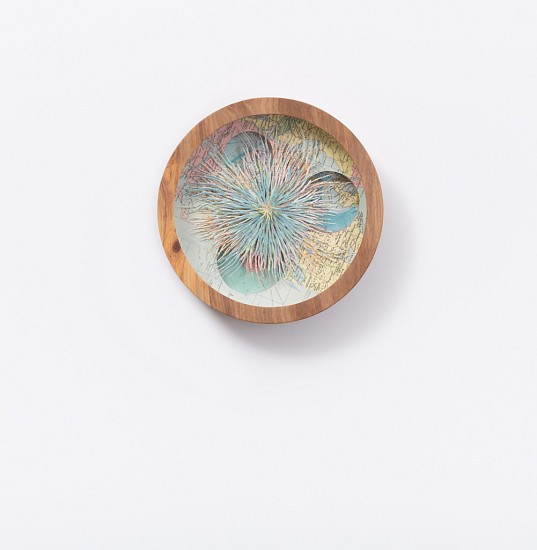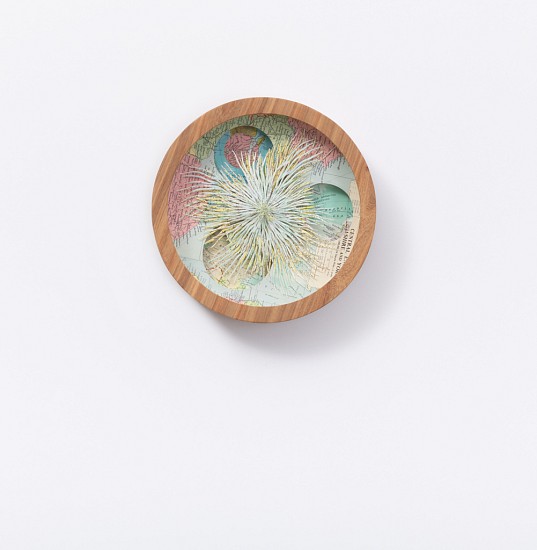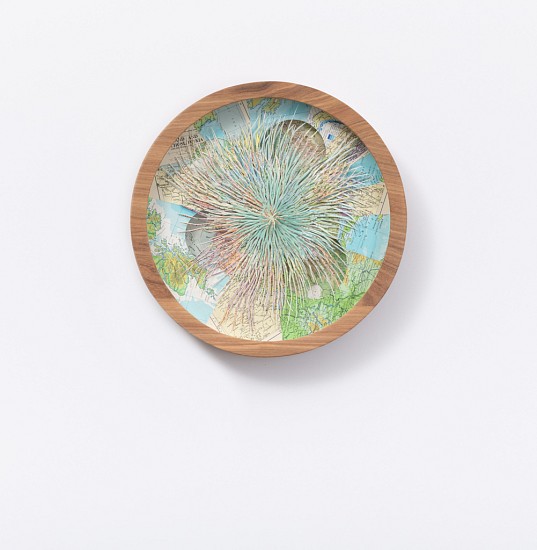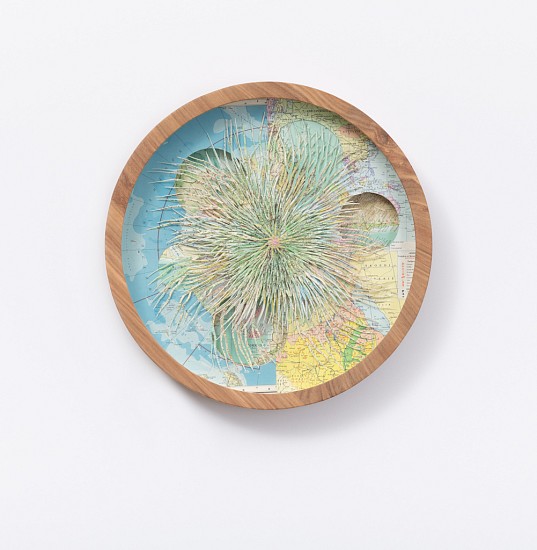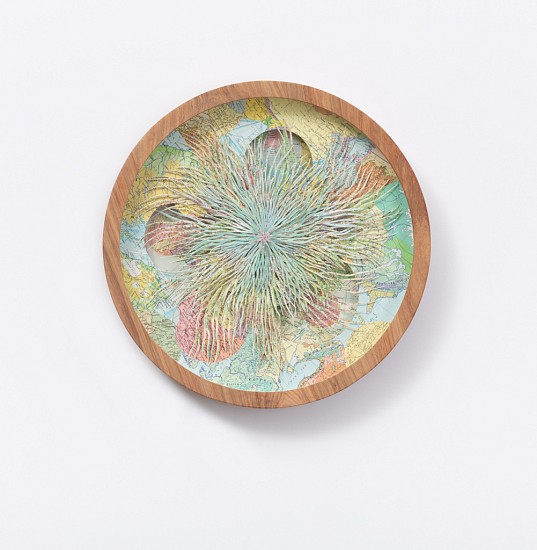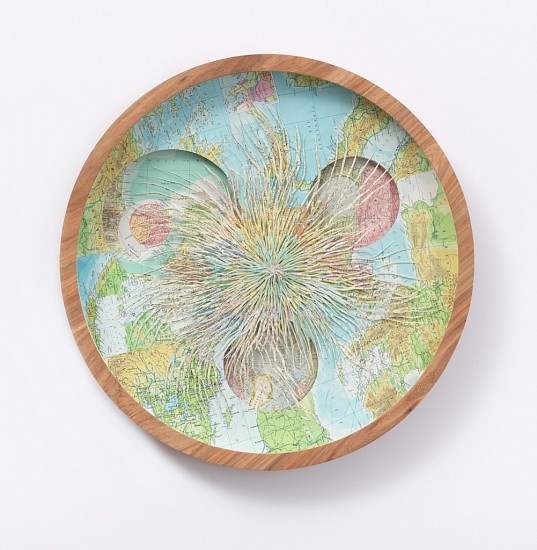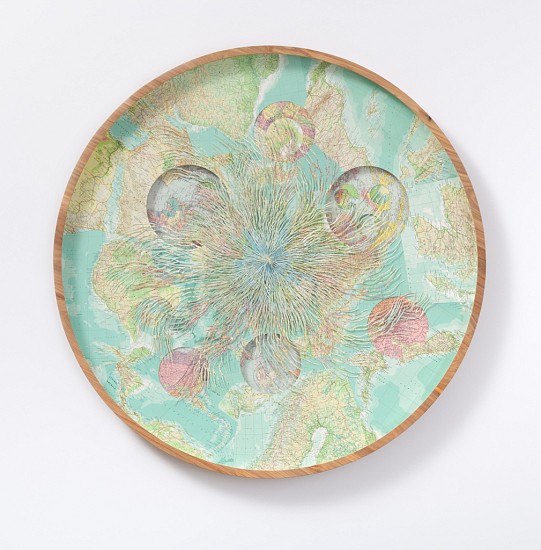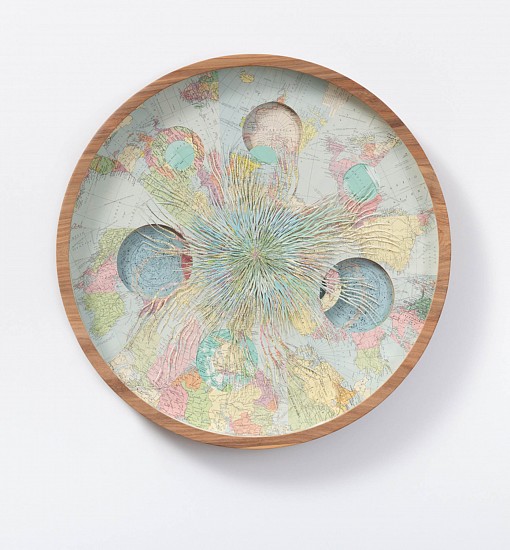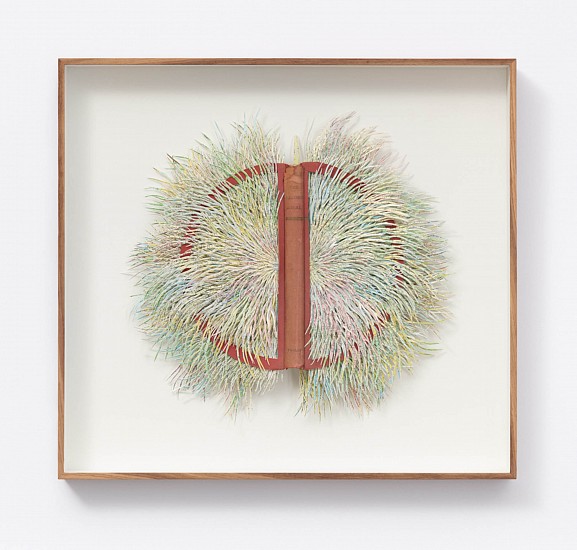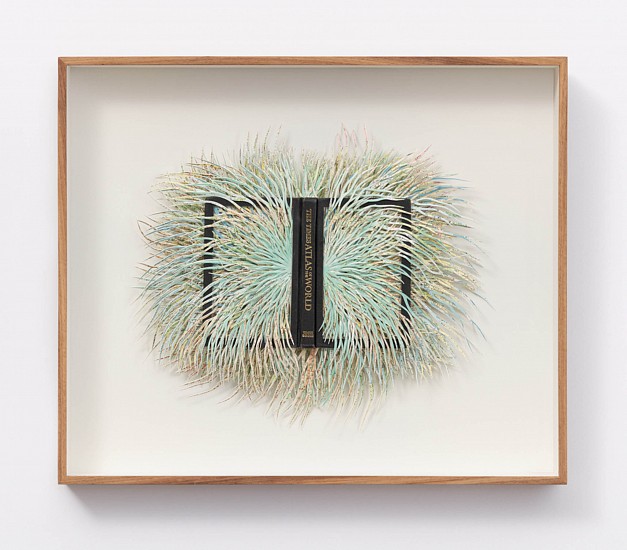TRANSITORY TERRAIN
Liza Grobler’s paintings spill over with runaway scribbles and vigorous mark-making, their composition evoking morphing landscapes - perhaps echoing the artist’s own relocation from urban to rural - and the immediacy of their energetic brushstrokes and dribbles of paint harking back to Abstract Expressionism.
In Grobler’s words, “These landscapes are directly related to my recent body of work, Disobedient Landscapes, but the works point - at least in spirit - to the very tactile textures of the Klein Karoo.*
The most valuable lesson I have learnt from the Covid landscape is: 'the only constant is change'. And as I have always been preoccupied with the route, rather than the destination, the uncertainty of the present has brought about a heightened sense of awareness of our actions and environments. It is this quality that I wish to capture - momentous fractions of the present. We became aware of the temporal nature of all our 'securities' and in a sense this is liberating!
The work is also a final curtsy from my urban studio. For the past 20 years, the suburb of Woodstock, Cape Town has been my base camp. In May 2021, my family and I relocated to Oudtshoorn, the capitol of the Klein Karoo. It seems that the emotional shifts in our environment necessitated a physical shift too. This work marks the start of that journey.”
* The Klein Karoo is a semi-desert natural region of South Africa -the southern sibling of the larger Karoo - the Great or Groot Karoo.
Contact: info@everardlondon.com
Image credit: Dan Weill Photography / Artist portrait: Frans Smit
Liza Grobler’s paintings spill over with runaway scribbles and vigorous mark-making, their composition evoking morphing landscapes - perhaps echoing the artist’s own relocation from urban to rural - and the immediacy of their energetic brushstrokes and dribbles of paint harking back to Abstract Expressionism.
In Grobler’s words, “These landscapes are directly related to my recent body of work, Disobedient Landscapes, but the works point - at least in spirit - to the very tactile textures of the Klein Karoo.*
The most valuable lesson I have learnt from the Covid landscape is: 'the only constant is change'. And as I have always been preoccupied with the route, rather than the destination, the uncertainty of the present has brought about a heightened sense of awareness of our actions and environments. It is this quality that I wish to capture - momentous fractions of the present. We became aware of the temporal nature of all our 'securities' and in a sense this is liberating!
The work is also a final curtsy from my urban studio. For the past 20 years, the suburb of Woodstock, Cape Town has been my base camp. In May 2021, my family and I relocated to Oudtshoorn, the capitol of the Klein Karoo. It seems that the emotional shifts in our environment necessitated a physical shift too. This work marks the start of that journey.”
* The Klein Karoo is a semi-desert natural region of South Africa -the southern sibling of the larger Karoo - the Great or Groot Karoo.
Contact: info@everardlondon.com
Image credit: Dan Weill Photography / Artist portrait: Frans Smit
Liza Grobler’s paintings spill over with runaway scribbles and vigorous mark-making, their composition evoking morphing landscapes - perhaps echoing the artist’s own relocation from urban to rural - and the immediacy of their energetic brushstrokes and dribbles of paint harking back to Abstract Expressionism.
In Grobler’s words, “These landscapes are directly related to my recent body of work, Disobedient Landscapes, but the works point - at least in spirit - to the very tactile textures of the Klein Karoo.*
The most valuable lesson I have learnt from the Covid landscape is: 'the only constant is change'. And as I have always been preoccupied with the route, rather than the destination, the uncertainty of the present has brought about a heightened sense of awareness of our actions and environments. It is this quality that I wish to capture - momentous fractions of the present. We became aware of the temporal nature of all our 'securities' and in a sense this is liberating!
The work is also a final curtsy from my urban studio. For the past 20 years, the suburb of Woodstock, Cape Town has been my base camp. In May 2021, my family and I relocated to Oudtshoorn, the capitol of the Klein Karoo. It seems that the emotional shifts in our environment necessitated a physical shift too. This work marks the start of that journey.”
* The Klein Karoo is a semi-desert natural region of South Africa -the southern sibling of the larger Karoo - the Great or Groot Karoo.
Contact: info@everardlondon.com
Image credit: Dan Weill Photography / Artist portrait: Frans Smit
Liza Grobler’s paintings spill over with runaway scribbles and vigorous mark-making, their composition evoking morphing landscapes - perhaps echoing the artist’s own relocation from urban to rural - and the immediacy of their energetic brushstrokes and dribbles of paint harking back to Abstract Expressionism.
In Grobler’s words, “These landscapes are directly related to my recent body of work, Disobedient Landscapes, but the works point - at least in spirit - to the very tactile textures of the Klein Karoo.*
The most valuable lesson I have learnt from the Covid landscape is: 'the only constant is change'. And as I have always been preoccupied with the route, rather than the destination, the uncertainty of the present has brought about a heightened sense of awareness of our actions and environments. It is this quality that I wish to capture - momentous fractions of the present. We became aware of the temporal nature of all our 'securities' and in a sense this is liberating!
The work is also a final curtsy from my urban studio. For the past 20 years, the suburb of Woodstock, Cape Town has been my base camp. In May 2021, my family and I relocated to Oudtshoorn, the capitol of the Klein Karoo. It seems that the emotional shifts in our environment necessitated a physical shift too. This work marks the start of that journey.”
* The Klein Karoo is a semi-desert natural region of South Africa -the southern sibling of the larger Karoo - the Great or Groot Karoo.
Contact: info@everardlondon.com
Artist portrait: Frans Smit
Created with watercolours, crayon, pastel and ink Lady Skollie’s works are fluid, whimsical, and teeming with floating figures and the fleeting beauty of florals in full bloom. Her imagery is playfully transgressive, defying stereotypes and taboos, while confronting issues of history, race, sex, pleasure, consent, violence, and abuse. In this exhibition a pair of works on paper call to mind rock art and cave paintings. Entitled Wipe Us Out they are tangled webs of entwined bodies with a chilling allusion to erasure and disappearance.
Lady Skollie’s works “resonate on a sensory level, while simultaneously referencing her personal history and confronting us with her depictions of subcultures of sexuality, dispossession and otherness. They immerse us in their own viscera and exuberance all the while venturing into the trepidatious terrain of history and identity politics.”*
* Hazel Friedman, June 2020
Contact: info@everardlondon.com
Image credit: Dan Weill Photography / Artist portrait: Courtesy the artist
Created with watercolours, crayon, pastel and ink Lady Skollie’s works are fluid, whimsical, and teeming with floating figures and the fleeting beauty of florals in full bloom. Her imagery is playfully transgressive, defying stereotypes and taboos, while confronting issues of history, race, sex, pleasure, consent, violence, and abuse. In this exhibition a pair of works on paper call to mind rock art and cave paintings. Entitled Wipe Us Out they are tangled webs of entwined bodies with a chilling allusion to erasure and disappearance.
Lady Skollie’s works “resonate on a sensory level, while simultaneously referencing her personal history and confronting us with her depictions of subcultures of sexuality, dispossession and otherness. They immerse us in their own viscera and exuberance all the while venturing into the trepidatious terrain of history and identity politics.”*
* Hazel Friedman, June 2020
Contact: info@everardlondon.com
Image credit: Dan Weill Photography / Artist portrait: Courtesy the artist
Created with watercolours, crayon, pastel and ink Lady Skollie’s works are fluid, whimsical, and teeming with floating figures and the fleeting beauty of florals in full bloom. Her imagery is playfully transgressive, defying stereotypes and taboos, while confronting issues of history, race, sex, pleasure, consent, violence, and abuse. In this exhibition a pair of works on paper call to mind rock art and cave paintings. Entitled Wipe Us Out they are tangled webs of entwined bodies with a chilling allusion to erasure and disappearance.
Lady Skollie’s works “resonate on a sensory level, while simultaneously referencing her personal history and confronting us with her depictions of subcultures of sexuality, dispossession and otherness. They immerse us in their own viscera and exuberance all the while venturing into the trepidatious terrain of history and identity politics.”*
* Hazel Friedman, June 2020
Contact: info@everardlondon.com
Image credit: Dan Weill Photography / Artist portrait: Courtesy the artist
Created with watercolours, crayon, pastel and ink Lady Skollie’s works are fluid, whimsical, and teeming with floating figures and the fleeting beauty of florals in full bloom. Her imagery is playfully transgressive, defying stereotypes and taboos, while confronting issues of history, race, sex, pleasure, consent, violence, and abuse. In this exhibition a pair of works on paper call to mind rock art and cave paintings. Entitled Wipe Us Out they are tangled webs of entwined bodies with a chilling allusion to erasure and disappearance.
Lady Skollie’s works “resonate on a sensory level, while simultaneously referencing her personal history and confronting us with her depictions of subcultures of sexuality, dispossession and otherness. They immerse us in their own viscera and exuberance all the while venturing into the trepidatious terrain of history and identity politics.”*
* Hazel Friedman, June 2020
Contact: info@everardlondon.com
Image credit: Dan Weill Photography / Artist portrait: Courtesy the artist
Created with watercolours, crayon, pastel and ink Lady Skollie’s works are fluid, whimsical, and teeming with floating figures and the fleeting beauty of florals in full bloom. Her imagery is playfully transgressive, defying stereotypes and taboos, while confronting issues of history, race, sex, pleasure, consent, violence, and abuse. In this exhibition a pair of works on paper call to mind rock art and cave paintings. Entitled Wipe Us Out they are tangled webs of entwined bodies with a chilling allusion to erasure and disappearance.
Lady Skollie’s works “resonate on a sensory level, while simultaneously referencing her personal history and confronting us with her depictions of subcultures of sexuality, dispossession and otherness. They immerse us in their own viscera and exuberance all the while venturing into the trepidatious terrain of history and identity politics.”*
* Hazel Friedman, June 2020
Contact: info@everardlondon.com
Image credit: Dan Weill Photography / Artist portrait: Courtesy the artist
This series of new paintings capture the essence of Penelope Stutterheime’s long-standing preoccupation with depicting inner landscapes. Drawing inspiration from dreams and the unconscious, her layered and textured paintings make use of thick impasto and vibrant colour to create mesmerising abstract works.
Collectively entitled Shrine these paintings speak of a spiritual architecture, “my inner Jerusalem” as Stutterheime suggests. The title also alludes to the artist’s place of making, her studio in Cape Town, and the spiritual process she undergoes in the making of her work. She describes “pouring” her emotions and feelings through rather than into a painting. The process is deeply cathartic, with the act of repeatedly applying oil paint to the canvas, serving as a meditative process for subconsciously working through emotions.
For Stutterheime, the call and response of colour, texture and shape is ultimately a desire to find “resolution of form and sensation. Gold paint is essential to her practice – “gold is my white” – and these works - bright, exuberant and lyrically colourful – the composition appears to shift endlessly, with patterns and hues surrendering the foreground and then claiming dominance again - an eternal, elusive dance of colour, shape and form.
Contact: info@everardlondon.com
Image credit: Michael Hall / Dan Weill Photography
This series of new paintings capture the essence of Penelope Stutterheime’s long-standing preoccupation with depicting inner landscapes. Drawing inspiration from dreams and the unconscious, her layered and textured paintings make use of thick impasto and vibrant colour to create mesmerising abstract works.
Collectively entitled Shrine these paintings speak of a spiritual architecture, “my inner Jerusalem” as Stutterheime suggests. The title also alludes to the artist’s place of making, her studio in Cape Town, and the spiritual process she undergoes in the making of her work. She describes “pouring” her emotions and feelings through rather than into a painting. The process is deeply cathartic, with the act of repeatedly applying oil paint to the canvas, serving as a meditative process for subconsciously working through emotions.
For Stutterheime, the call and response of colour, texture and shape is ultimately a desire to find “resolution of form and sensation. Gold paint is essential to her practice – “gold is my white” – and these works - bright, exuberant and lyrically colourful – the composition appears to shift endlessly, with patterns and hues surrendering the foreground and then claiming dominance again - an eternal, elusive dance of colour, shape and form.
Contact: info@everardlondon.com
Image credit: Michael Hall / Dan Weill Photography
This series of new paintings capture the essence of Penelope Stutterheime’s long-standing preoccupation with depicting inner landscapes. Drawing inspiration from dreams and the unconscious, her layered and textured paintings make use of thick impasto and vibrant colour to create mesmerising abstract works.
Collectively entitled Shrine these paintings speak of a spiritual architecture, “my inner Jerusalem” as Stutterheime suggests. The title also alludes to the artist’s place of making, her studio in Cape Town, and the spiritual process she undergoes in the making of her work. She describes “pouring” her emotions and feelings through rather than into a painting. The process is deeply cathartic, with the act of repeatedly applying oil paint to the canvas, serving as a meditative process for subconsciously working through emotions.
For Stutterheime, the call and response of colour, texture and shape is ultimately a desire to find “resolution of form and sensation. Gold paint is essential to her practice – “gold is my white” – and these works - bright, exuberant and lyrically colourful – the composition appears to shift endlessly, with patterns and hues surrendering the foreground and then claiming dominance again - an eternal, elusive dance of colour, shape and form.
Contact: info@everardlondon.com
Image credit: Michael Hall / Dan Weill Photography
This series of new paintings capture the essence of Penelope Stutterheime’s long-standing preoccupation with depicting inner landscapes. Drawing inspiration from dreams and the unconscious, her layered and textured paintings make use of thick impasto and vibrant colour to create mesmerising abstract works.
Collectively entitled Shrine these paintings speak of a spiritual architecture, “my inner Jerusalem” as Stutterheime suggests. The title also alludes to the artist’s place of making, her studio in Cape Town, and the spiritual process she undergoes in the making of her work. She describes “pouring” her emotions and feelings through rather than into a painting. The process is deeply cathartic, with the act of repeatedly applying oil paint to the canvas, serving as a meditative process for subconsciously working through emotions.
For Stutterheime, the call and response of colour, texture and shape is ultimately a desire to find “resolution of form and sensation. Gold paint is essential to her practice – “gold is my white” – and these works - bright, exuberant and lyrically colourful – the composition appears to shift endlessly, with patterns and hues surrendering the foreground and then claiming dominance again - an eternal, elusive dance of colour, shape and form.
Contact: info@everardlondon.com
Image credit: Michael Hall / Dan Weill Photography
This series of new paintings capture the essence of Penelope Stutterheime’s long-standing preoccupation with depicting inner landscapes. Drawing inspiration from dreams and the unconscious, her layered and textured paintings make use of thick impasto and vibrant colour to create mesmerising abstract works.
Collectively entitled Shrine these paintings speak of a spiritual architecture, “my inner Jerusalem” as Stutterheime suggests. The title also alludes to the artist’s place of making, her studio in Cape Town, and the spiritual process she undergoes in the making of her work. She describes “pouring” her emotions and feelings through rather than into a painting. The process is deeply cathartic, with the act of repeatedly applying oil paint to the canvas, serving as a meditative process for subconsciously working through emotions.
For Stutterheime, the call and response of colour, texture and shape is ultimately a desire to find “resolution of form and sensation. Gold paint is essential to her practice – “gold is my white” – and these works - bright, exuberant and lyrically colourful – the composition appears to shift endlessly, with patterns and hues surrendering the foreground and then claiming dominance again - an eternal, elusive dance of colour, shape and form.
Contact: info@everardlondon.com
Image credit: Michael Hall / Dan Weill Photography
This series of new paintings capture the essence of Penelope Stutterheime’s long-standing preoccupation with depicting inner landscapes. Drawing inspiration from dreams and the unconscious, her layered and textured paintings make use of thick impasto and vibrant colour to create mesmerising abstract works.
Collectively entitled Shrine these paintings speak of a spiritual architecture, “my inner Jerusalem” as Stutterheime suggests. The title also alludes to the artist’s place of making, her studio in Cape Town, and the spiritual process she undergoes in the making of her work. She describes “pouring” her emotions and feelings through rather than into a painting. The process is deeply cathartic, with the act of repeatedly applying oil paint to the canvas, serving as a meditative process for subconsciously working through emotions.
For Stutterheime, the call and response of colour, texture and shape is ultimately a desire to find “resolution of form and sensation. Gold paint is essential to her practice – “gold is my white” – and these works - bright, exuberant and lyrically colourful – the composition appears to shift endlessly, with patterns and hues surrendering the foreground and then claiming dominance again - an eternal, elusive dance of colour, shape and form.
Contact: info@everardlondon.com
Image credit: Dan Weill Photography / Michael Hall
Rina Stutzer’s work is elusive; in a constant process of becoming, the pieces evolving out of each other, often guided by intuitive impulses. She is drawn to making works that are not fixed; whose identity is ambiguous (as with the crow) and transitory, provisional (as with the nomad). All we know of the world is that we are passing through it and the the works in this exhibition poignantly telegraph the impermanence of all things.
“Stutzer uses crows in her work as a metaphor for human beings and their place in the world. We are reminded of Ted Hughes’s crow poems – where the corvid is infinitely adaptable, unpredictable, inexhaustible, and capable of mischief. Here the crow also stands for the artist herself: both operate outside of society, both are subversive, and both are tricksters playing with the possibilities of reality.
The tent is a recurring image in her work and here Stutzer’s structure is made of delicate and ephemeral twigs - a temporary dwelling, not unlike our own skins, that we inhabit during our journey through the world. “The tent is explicitly yonic in many of Stutzer’s works; we are reminded of the emergence of humanity into the world, the birth of a child – the human spirit moving from womb to world, belonging in neither, only ever visiting both.” - Miranthe Staden Garbett
Stutzer’s female form in “corpse pose” is between life and death, in a state of transition between different realms, impossible to pin down.
Contact: info@everardlondon.com
Image credit: Carla Crafford / Dan Weill Photography
Rina Stutzer’s work is elusive; in a constant process of becoming, the pieces evolving out of each other, often guided by intuitive impulses. She is drawn to making works that are not fixed; whose identity is ambiguous (as with the crow) and transitory, provisional (as with the nomad). All we know of the world is that we are passing through it and the the works in this exhibition poignantly telegraph the impermanence of all things.
“Stutzer uses crows in her work as a metaphor for human beings and their place in the world. We are reminded of Ted Hughes’s crow poems – where the corvid is infinitely adaptable, unpredictable, inexhaustible, and capable of mischief. Here the crow also stands for the artist herself: both operate outside of society, both are subversive, and both are tricksters playing with the possibilities of reality.
The tent is a recurring image in her work and here Stutzer’s structure is made of delicate and ephemeral twigs - a temporary dwelling, not unlike our own skins, that we inhabit during our journey through the world. “The tent is explicitly yonic in many of Stutzer’s works; we are reminded of the emergence of humanity into the world, the birth of a child – the human spirit moving from womb to world, belonging in neither, only ever visiting both.” - Miranthe Staden Garbett
Stutzer’s female form in “corpse pose” is between life and death, in a state of transition between different realms, impossible to pin down.
Contact: info@everardlondon.com
Image credit: Carla Crafford / Dan Weill Photography
Rina Stutzer’s work is elusive; in a constant process of becoming, the pieces evolving out of each other, often guided by intuitive impulses. She is drawn to making works that are not fixed; whose identity is ambiguous (as with the crow) and transitory, provisional (as with the nomad). All we know of the world is that we are passing through it and the the works in this exhibition poignantly telegraph the impermanence of all things.
“Stutzer uses crows in her work as a metaphor for human beings and their place in the world. We are reminded of Ted Hughes’s crow poems – where the corvid is infinitely adaptable, unpredictable, inexhaustible, and capable of mischief. Here the crow also stands for the artist herself: both operate outside of society, both are subversive, and both are tricksters playing with the possibilities of reality.
The tent is a recurring image in her work and here Stutzer’s structure is made of delicate and ephemeral twigs - a temporary dwelling, not unlike our own skins, that we inhabit during our journey through the world. “The tent is explicitly yonic in many of Stutzer’s works; we are reminded of the emergence of humanity into the world, the birth of a child – the human spirit moving from womb to world, belonging in neither, only ever visiting both.” - Miranthe Staden Garbett
Stutzer’s female form in “corpse pose” is between life and death, in a state of transition between different realms, impossible to pin down.
Contact: info@everardlondon.com
Image credit: Carla Crafford / Dan Weill Photography
Rina Stutzer’s work is elusive; in a constant process of becoming, the pieces evolving out of each other, often guided by intuitive impulses. She is drawn to making works that are not fixed; whose identity is ambiguous (as with the crow) and transitory, provisional (as with the nomad). All we know of the world is that we are passing through it and the the works in this exhibition poignantly telegraph the impermanence of all things.
“Stutzer uses crows in her work as a metaphor for human beings and their place in the world. We are reminded of Ted Hughes’s crow poems – where the corvid is infinitely adaptable, unpredictable, inexhaustible, and capable of mischief. Here the crow also stands for the artist herself: both operate outside of society, both are subversive, and both are tricksters playing with the possibilities of reality.
The tent is a recurring image in her work and here Stutzer’s structure is made of delicate and ephemeral twigs - a temporary dwelling, not unlike our own skins, that we inhabit during our journey through the world. “The tent is explicitly yonic in many of Stutzer’s works; we are reminded of the emergence of humanity into the world, the birth of a child – the human spirit moving from womb to world, belonging in neither, only ever visiting both.” - Miranthe Staden Garbett
Stutzer’s female form in “corpse pose” is between life and death, in a state of transition between different realms, impossible to pin down.
Contact: info@everardlondon.com
Image credit: Carla Crafford / Dan Weill Photography
Rina Stutzer’s work is elusive; in a constant process of becoming, the pieces evolving out of each other, often guided by intuitive impulses. She is drawn to making works that are not fixed; whose identity is ambiguous (as with the crow) and transitory, provisional (as with the nomad). All we know of the world is that we are passing through it and the the works in this exhibition poignantly telegraph the impermanence of all things.
“Stutzer uses crows in her work as a metaphor for human beings and their place in the world. We are reminded of Ted Hughes’s crow poems – where the corvid is infinitely adaptable, unpredictable, inexhaustible, and capable of mischief. Here the crow also stands for the artist herself: both operate outside of society, both are subversive, and both are tricksters playing with the possibilities of reality.
The tent is a recurring image in her work and here Stutzer’s structure is made of delicate and ephemeral twigs - a temporary dwelling, not unlike our own skins, that we inhabit during our journey through the world. “The tent is explicitly yonic in many of Stutzer’s works; we are reminded of the emergence of humanity into the world, the birth of a child – the human spirit moving from womb to world, belonging in neither, only ever visiting both.” - Miranthe Staden Garbett
Stutzer’s female form in “corpse pose” is between life and death, in a state of transition between different realms, impossible to pin down.
Contact: info@everardlondon.com
Image credit: Carla Crafford / Dan Weill Photography
Rina Stutzer’s work is elusive; in a constant process of becoming, the pieces evolving out of each other, often guided by intuitive impulses. She is drawn to making works that are not fixed; whose identity is ambiguous (as with the crow) and transitory, provisional (as with the nomad). All we know of the world is that we are passing through it and the the works in this exhibition poignantly telegraph the impermanence of all things.
“Stutzer uses crows in her work as a metaphor for human beings and their place in the world. We are reminded of Ted Hughes’s crow poems – where the corvid is infinitely adaptable, unpredictable, inexhaustible, and capable of mischief. Here the crow also stands for the artist herself: both operate outside of society, both are subversive, and both are tricksters playing with the possibilities of reality.
The tent is a recurring image in her work and here Stutzer’s structure is made of delicate and ephemeral twigs - a temporary dwelling, not unlike our own skins, that we inhabit during our journey through the world. “The tent is explicitly yonic in many of Stutzer’s works; we are reminded of the emergence of humanity into the world, the birth of a child – the human spirit moving from womb to world, belonging in neither, only ever visiting both.” - Miranthe Staden Garbett
Stutzer’s female form in “corpse pose” is between life and death, in a state of transition between different realms, impossible to pin down.
Contact: info@everardlondon.com
Image credit: Carla Crafford / Dan Weill Photography
Barbara Wildenboer’s reimagined maps are ticking timepieces that speak of shifting borders shaped by geopolitics, geology, and climate, while her altered books breathe renewed life into previously prized objects that are disappearing into obsolescence in our digital age.
The artist’s use of old books and maps invites us to consider ways in which humans feel compelled to interpret, fix and navigate the mysteries of life with atlases, maps and scientific devices. Guided by her intuition, the artist herself is on a quest to understand more. Magnetism, gravity and electricity, the celestial orbits and star cycles are all phenomena ‘discovered’ by science, yet their mysteries have not yet been entirely revealed. *
*Extract from an original text by Miranthe Staden Garbett, 2020
Contact: info@everardlondon.com
Image credit: Michael Hall / Dan Weill Photography
Barbara Wildenboer’s reimagined maps are ticking timepieces that speak of shifting borders shaped by geopolitics, geology, and climate, while her altered books breathe renewed life into previously prized objects that are disappearing into obsolescence in our digital age.
The artist’s use of old books and maps invites us to consider ways in which humans feel compelled to interpret, fix and navigate the mysteries of life with atlases, maps and scientific devices. Guided by her intuition, the artist herself is on a quest to understand more. Magnetism, gravity and electricity, the celestial orbits and star cycles are all phenomena ‘discovered’ by science, yet their mysteries have not yet been entirely revealed. *
*Extract from an original text by Miranthe Staden Garbett, 2020
Contact: info@everardlondon.com
Image credit: Michael Hall / Dan Weill Photography
Barbara Wildenboer’s reimagined maps are ticking timepieces that speak of shifting borders shaped by geopolitics, geology, and climate, while her altered books breathe renewed life into previously prized objects that are disappearing into obsolescence in our digital age.
The artist’s use of old books and maps invites us to consider ways in which humans feel compelled to interpret, fix and navigate the mysteries of life with atlases, maps and scientific devices. Guided by her intuition, the artist herself is on a quest to understand more. Magnetism, gravity and electricity, the celestial orbits and star cycles are all phenomena ‘discovered’ by science, yet their mysteries have not yet been entirely revealed. *
*Extract from an original text by Miranthe Staden Garbett, 2020
Contact: info@everardlondon.com
Barbara Wildenboer’s reimagined maps are ticking timepieces that speak of shifting borders shaped by geopolitics, geology, and climate, while her altered books breathe renewed life into previously prized objects that are disappearing into obsolescence in our digital age.
The artist’s use of old books and maps invites us to consider ways in which humans feel compelled to interpret, fix and navigate the mysteries of life with atlases, maps and scientific devices. Guided by her intuition, the artist herself is on a quest to understand more. Magnetism, gravity and electricity, the celestial orbits and star cycles are all phenomena ‘discovered’ by science, yet their mysteries have not yet been entirely revealed. *
*Extract from an original text by Miranthe Staden Garbett, 2020
Contact: info@everardlondon.com
Barbara Wildenboer’s reimagined maps are ticking timepieces that speak of shifting borders shaped by geopolitics, geology, and climate, while her altered books breathe renewed life into previously prized objects that are disappearing into obsolescence in our digital age.
The artist’s use of old books and maps invites us to consider ways in which humans feel compelled to interpret, fix and navigate the mysteries of life with atlases, maps and scientific devices. Guided by her intuition, the artist herself is on a quest to understand more. Magnetism, gravity and electricity, the celestial orbits and star cycles are all phenomena ‘discovered’ by science, yet their mysteries have not yet been entirely revealed. *
*Extract from an original text by Miranthe Staden Garbett, 2020
Contact: info@everardlondon.com
Image credit: Michael Hall / Dan Weill Photography
Barbara Wildenboer’s reimagined maps are ticking timepieces that speak of shifting borders shaped by geopolitics, geology, and climate, while her altered books breathe renewed life into previously prized objects that are disappearing into obsolescence in our digital age.
The artist’s use of old books and maps invites us to consider ways in which humans feel compelled to interpret, fix and navigate the mysteries of life with atlases, maps and scientific devices. Guided by her intuition, the artist herself is on a quest to understand more. Magnetism, gravity and electricity, the celestial orbits and star cycles are all phenomena ‘discovered’ by science, yet their mysteries have not yet been entirely revealed. *
*Extract from an original text by Miranthe Staden Garbett, 2020
Contact: info@everardlondon.com
Image credit: Michael Hall / Dan Weill Photography
Barbara Wildenboer’s reimagined maps are ticking timepieces that speak of shifting borders shaped by geopolitics, geology, and climate, while her altered books breathe renewed life into previously prized objects that are disappearing into obsolescence in our digital age.
The artist’s use of old books and maps invites us to consider ways in which humans feel compelled to interpret, fix and navigate the mysteries of life with atlases, maps and scientific devices. Guided by her intuition, the artist herself is on a quest to understand more. Magnetism, gravity and electricity, the celestial orbits and star cycles are all phenomena ‘discovered’ by science, yet their mysteries have not yet been entirely revealed. *
*Extract from an original text by Miranthe Staden Garbett, 2020
Contact: info@everardlondon.com
Image credit: Michael Hall / Dan Weill Photography
Barbara Wildenboer’s reimagined maps are ticking timepieces that speak of shifting borders shaped by geopolitics, geology, and climate, while her altered books breathe renewed life into previously prized objects that are disappearing into obsolescence in our digital age.
The artist’s use of old books and maps invites us to consider ways in which humans feel compelled to interpret, fix and navigate the mysteries of life with atlases, maps and scientific devices. Guided by her intuition, the artist herself is on a quest to understand more. Magnetism, gravity and electricity, the celestial orbits and star cycles are all phenomena ‘discovered’ by science, yet their mysteries have not yet been entirely revealed. *
*Extract from an original text by Miranthe Staden Garbett, 2020
Contact: info@everardlondon.com
Image credit: Michael Hall / Dan Weill Photography
Barbara Wildenboer’s reimagined maps are ticking timepieces that speak of shifting borders shaped by geopolitics, geology, and climate, while her altered books breathe renewed life into previously prized objects that are disappearing into obsolescence in our digital age.
The artist’s use of old books and maps invites us to consider ways in which humans feel compelled to interpret, fix and navigate the mysteries of life with atlases, maps and scientific devices. Guided by her intuition, the artist herself is on a quest to understand more. Magnetism, gravity and electricity, the celestial orbits and star cycles are all phenomena ‘discovered’ by science, yet their mysteries have not yet been entirely revealed. *
*Extract from an original text by Miranthe Staden Garbett, 2020
Contact: info@everardlondon.com
Image credit: Michael Hall / Dan Weill Photography
Barbara Wildenboer’s reimagined maps are ticking timepieces that speak of shifting borders shaped by geopolitics, geology, and climate, while her altered books breathe renewed life into previously prized objects that are disappearing into obsolescence in our digital age.
The artist’s use of old books and maps invites us to consider ways in which humans feel compelled to interpret, fix and navigate the mysteries of life with atlases, maps and scientific devices. Guided by her intuition, the artist herself is on a quest to understand more. Magnetism, gravity and electricity, the celestial orbits and star cycles are all phenomena ‘discovered’ by science, yet their mysteries have not yet been entirely revealed. *
*Extract from an original text by Miranthe Staden Garbett, 2020
Contact: info@everardlondon.com
Image credit: Michael Hall / Dan Weill Photography
Barbara Wildenboer’s reimagined maps are ticking timepieces that speak of shifting borders shaped by geopolitics, geology, and climate, while her altered books breathe renewed life into previously prized objects that are disappearing into obsolescence in our digital age.
The artist’s use of old books and maps invites us to consider ways in which humans feel compelled to interpret, fix and navigate the mysteries of life with atlases, maps and scientific devices. Guided by her intuition, the artist herself is on a quest to understand more. Magnetism, gravity and electricity, the celestial orbits and star cycles are all phenomena ‘discovered’ by science, yet their mysteries have not yet been entirely revealed. *
*Extract from an original text by Miranthe Staden Garbett, 2020
Contact: info@everardlondon.com
Image credit: Michael Hall / Dan Weill Photography
Barbara Wildenboer’s reimagined maps are ticking timepieces that speak of shifting borders shaped by geopolitics, geology, and climate, while her altered books breathe renewed life into previously prized objects that are disappearing into obsolescence in our digital age.
The artist’s use of old books and maps invites us to consider ways in which humans feel compelled to interpret, fix and navigate the mysteries of life with atlases, maps and scientific devices. Guided by her intuition, the artist herself is on a quest to understand more. Magnetism, gravity and electricity, the celestial orbits and star cycles are all phenomena ‘discovered’ by science, yet their mysteries have not yet been entirely revealed. *
*Extract from an original text by Miranthe Staden Garbett, 2020
Contact: info@everardlondon.com
Image credit: Michael Hall / Dan Weill Photography






































